- Crypto Pragmatist by M6 Labs
- Posts
- From Uptober to Uncertainty
From Uptober to Uncertainty
Market Struggles To Rebound, BTC Below Key Levels, Liquidity Stays Thin
GM Anon
What a week. The momentum from early October got crushed after last week’s brutal liquidation event, leaving markets limping into the weekend. What looked like the start of a real Uptober run quickly turned defensive as fear took over. Gold’s ripping, stocks are shaky, and crypto’s struggling to find its footing. Let’s break it down.
TLDR
Markets turned defensive again as regional bank stress hit stocks and risk sentiment weakened further.
Fed Chair Powell hinted QT could end soon, sparking speculation of a liquidity turn.
BTC ETFs saw the largest outflows since August, pushing traders to hedge below $100K.
SOL pulled back with the broader market but remains one of the stronger majors, supported by accelerating ETF progress and steady treasury demand.
BNB’s week was volatile amid Binance refund headlines and ecosystem airdrops.
Funding rates collapsed across majors, signaling a deep leverage unwind in progress.
Morpho crossed $11.9B TVL, quietly cementing its place as a DeFi heavyweight.
Memecoins bled further as capital rotated into AI-linked and blue-chip projects.
Join The Coiners + Get in on the $50K Grid Bot Challenge 🚀
Don’t wait, Anon — it’s free and will level up your trading game. As a member, you’ll unlock:
High-calibre crypto trading alerts
Weekly live streams with expert trader Michael Whitman (Wed Q&A + Fri Market Recap)
Real-time strategies straight from the pros
🔥 Plus, get front-row access to our $50K Grid Bot Challenge — we’re putting $50K into Pionex Grid Bots and you can follow along every step:
✅ Learn the exact ranges + settings we use
✅ Copy the bots into your own account with 1 click
✅ Track live results in real time
✅ Vote on the “Coin of the Week” for a short-term bot
The mission: turn $50K into 6 figures while showing you how to run profitable bots yourself.
Want more? Qualify for VIP access by meeting one of these:
Deposit $100K+ through a partner exchange
Trade $1M+ in monthly volume
Refer 3 friends who sign up
Stay sharp, stay active, and keep stacking edge with The Coiners.
Market Update
Markets closed the week on the back foot, with sentiment turning uneasy across both equities and crypto after what initially looked like a potential rebound from last week’s major liquidation event. Regional-bank loan stress hit U.S. stocks and dragged risk assets lower, even as gold pushed into new all-time highs and Treasury yields fell to their lowest since April. Fed Chair Jerome Powell added a new twist, signaling that quantitative tightening may be nearing its end as money markets start to feel the strain—a potentially bullish shift for liquidity, though the timing of any return to easing remains uncertain.
Futures found some footing after Trump hinted that China tariffs would be lifted, but overall risk appetite stayed muted. In crypto, that caution turned to fear: spot BTC ETFs saw their largest outflows since August, and Polymarket odds crossed above 50% for BTC to fall below $100K, signaling that traders are actively hedging against a deeper pullback.

BTC’s weakness has started to test confidence across the majors. The U.S. government moved another $75M in BTC this week, adding to the pressure, even though total state holdings remain around $36B after the DoJ seizures. Some desks are still accumulating—Strategy, as usual, announced a $27M BTC purchase during the dip—but most flows remain defensive.

ETH held up slightly better, supported by institutional buying signals like Sharplink’s $77M allocation and incoming custody rails from Citi and Amundi. SOL continues to lead the L1 pack, buoyed by CME’s new SOL and XRP options, growing ETF speculation, and direct treasury demand—Solmate reportedly bought $50M from the foundation and DFDV added another $16M. BNB’s week was more chaotic: the token popped after an airdrop campaign, but headlines around Binance’s $400M user refund plan and listing-cost criticism offset much of the goodwill.

Behind the price action, the institutional buildout hasn’t slowed. BlackRock plans to roll out its own tokenisation stack and a GENIUS-compliant money market fund, with Larry Fink again drawing parallels between crypto and gold. S&P’s stablecoin ratings via Chainlink and ODDO’s euro-backed EUROD launch mark another step toward on-chain capital markets.
Schwab’s plan to offer crypto trading by mid-2026 highlights how traditional finance continues to deepen its integration with digital assets, even as short-term liquidity remains thin. Further treasury and corporate activity echoed the same trend—Antalpha bought $134M in XAUT, Ripple acquired GTreasury for $1B while leading another $1B XRP fundraise, and Anchorage, Figure, and Sky all advanced new infrastructure and tokenisation initiatives.

DeFi and consumer rails stayed active despite the correction. Uniswap’s web app now supports Solana, OpenSea’s second wave went live, and Magic Eden is preparing “pack drops.” MetaMask’s collaboration with Polymarket—just as the latter opens stock-price betting—shows how prediction markets and retail flow are beginning to merge.

Regulation stayed busy too: Japan is moving to ban insider trading in crypto, France expanded AML checks, and the U.S. advanced a bill to enshrine Trump’s executive order on 401(k) crypto exposure. Corporate tokenisation threads continued with Eric Trump and WLFI planning a real-estate token project.

Memecoins remain in capitulation mode: market cap’s down 30% this month, XPL collapsed 75% in twenty days, and even new listings on Robinhood (ASTER, XPL, VIRTUALS) failed to spark a bid. Alt strength has narrowed to a handful of names like TAO, which rallied after an $11M raise. Overall, it feels like markets are trying to base—but the mood is fragile. ETF outflows, fading retail momentum, and persistent risk-off signals make this more of a test of conviction than a setup for a clean reversal. For now, traders are watching whether BTC can stabilize above the psychological line before that $100K threshold becomes a magnet.
Market Data Points
Over the past week, Arbitrum has been the clear outlier in a market otherwise defined by defensive positioning and liquidity withdrawal. Despite the broader downturn and heavy deleveraging across crypto, Arbitrum absorbed nearly $1B in net inflows, signaling that capital is rotating — not retreating entirely — but concentrating in deeper, safer ecosystems. By contrast, Hyperliquid, Unichain, and BNB Chain saw sharp outflows, consistent with traders unwinding risk from smaller or more speculative environments.
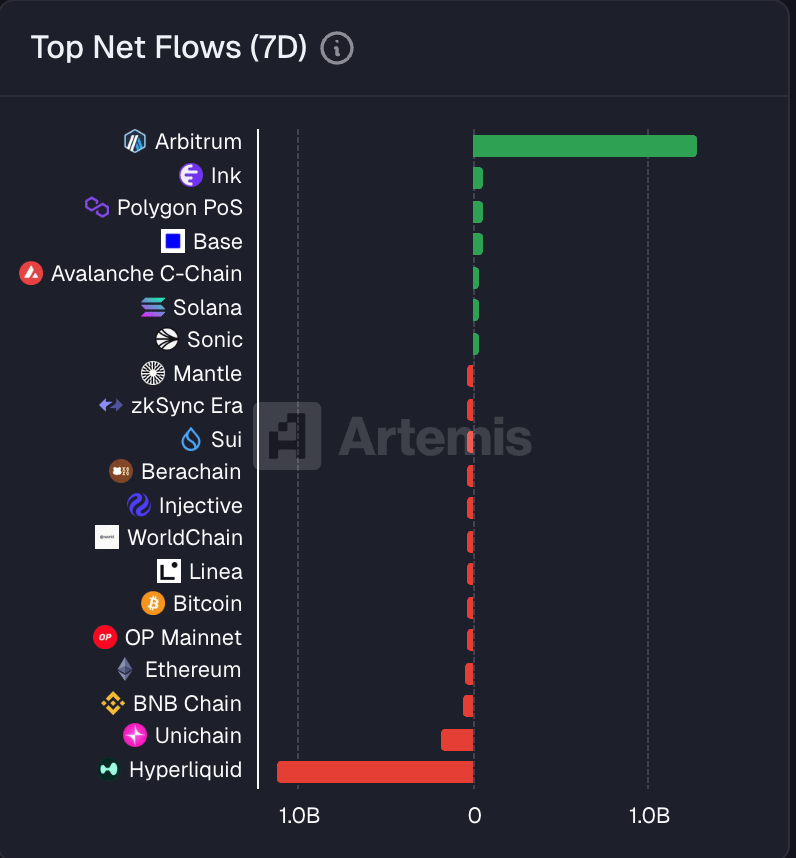
ETF flow trends in October have flipped sharply after what started as a strong month for inflows. During the first week, both BTC and ETH ETFs saw steady demand — daily inflows frequently topped $1B combined as traders repositioned after September’s correction. Momentum looked healthy, with institutional desks rebuilding exposure and market sentiment turning cautiously optimistic.
That tone reversed quickly after the mid-month drawdown. As volatility spiked and crypto prices retraced, flows turned decisively negative. BTC ETFs have now shed over $500M in the past few sessions, while ETH products are down roughly $60 million, marking one of the heaviest weekly outflows since late spring.
The takeaway: what began as a renewed accumulation phase has morphed into a capital retreat, driven less by conviction shifts and more by short-term deleveraging. ETF investors appear to be trimming exposure in step with the broader futures market — not exiting the asset class, but waiting for clearer macro signals before redeploying.

SOL’s ETF story is accelerating fast. While no pure U.S. spot Solana ETF is trading yet, filings from 21Shares, VanEck, and Bitwise have advanced to their final procedural stages with the SEC — including Form 8-A12B registrations that typically precede listing approvals. In parallel, hybrid and futures-based Solana products like REX-Osprey’s SOL + Staking ETF and several leveraged SOL funds have already gone live, fueling a sharp rise in institutional exposure.
Cumulative SOL ETF and futures volumes have now topped $15B, reflecting surging demand from regulated capital. With BTC and ETH spot ETFs already established, SOL is rapidly emerging as the third pillar of regulated crypto exposure, and the upcoming 21Shares Solana ETF launch could mark its official entry into mainstream portfolios.
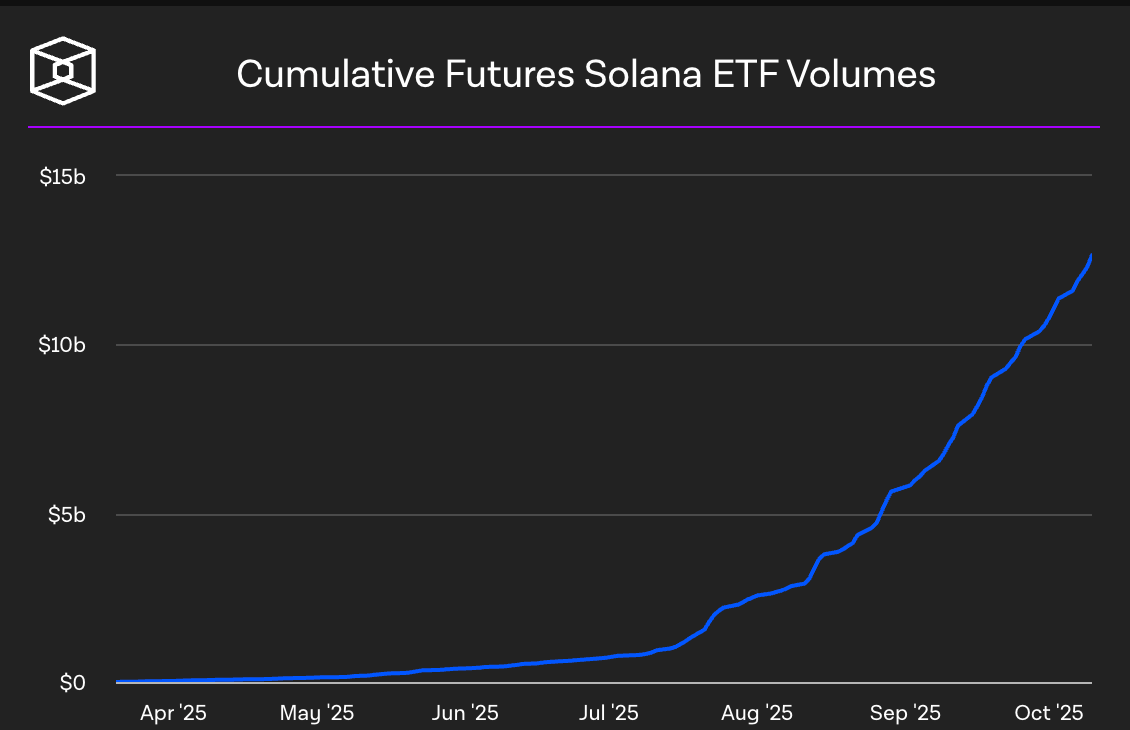
Perpetual funding rates have collapsed across nearly every major crypto asset, plunging to levels not seen since the bear-market capitulation of 2022. What’s unfolding now is a full-scale leverage unwind — traders de-risking, liquidations clearing out crowded longs, and open interest resetting after months of aggressive positioning.
This kind of deep funding compression is rare. It typically marks the end of speculative excess, when overextended leverage gets purged and only committed spot holders remain. The result is a cleaner, more balanced market structure — one that often precedes stronger, more sustainable rallies once liquidity and conviction return.
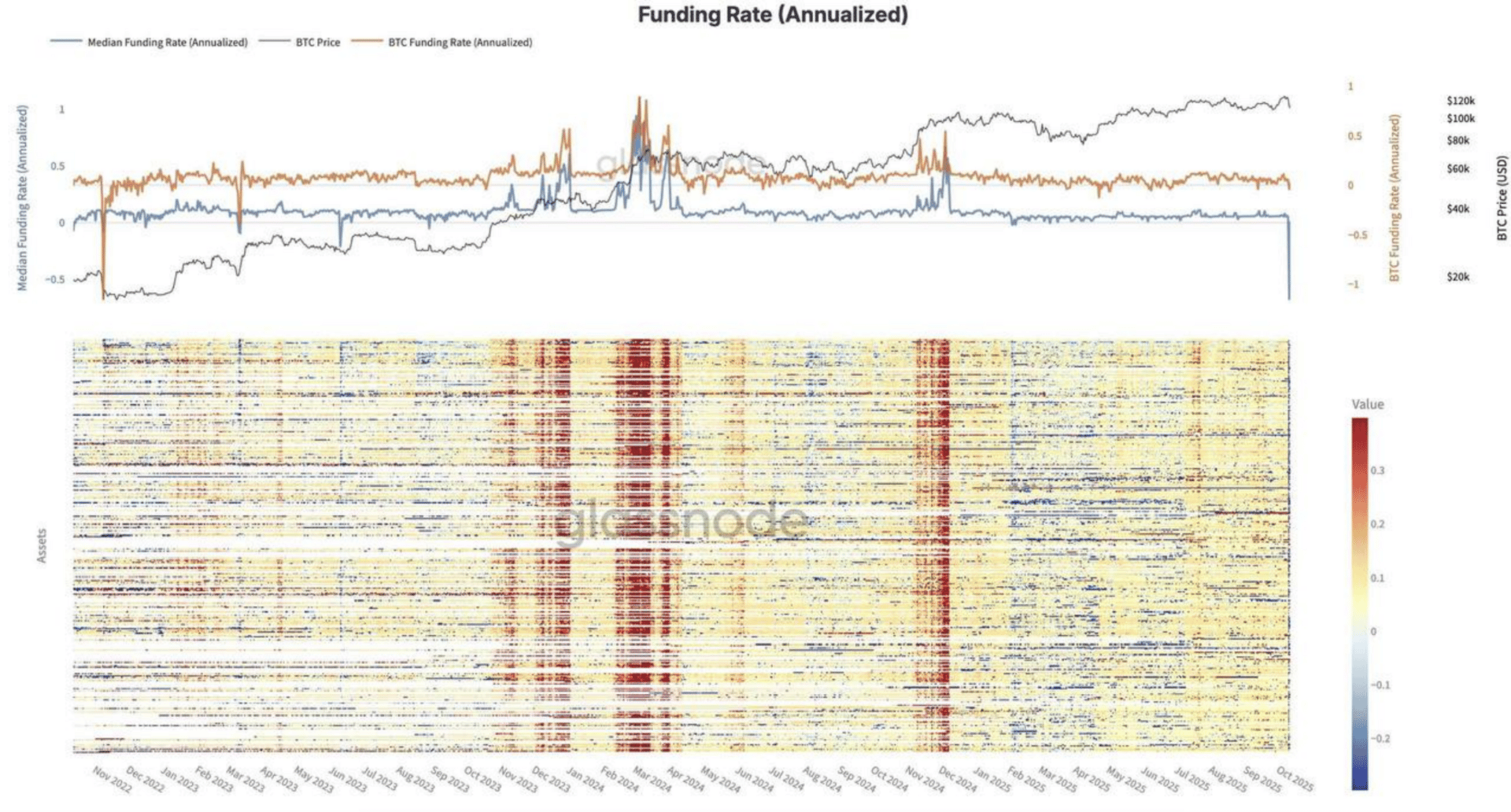
Morpho has quietly become one of the largest protocols in all of DeFi, with total value locked now above $11.9B. The lending platform’s rapid climb reflects deep integrations with blue-chip assets and growing user preference for its peer-to-peer optimization layer, which improves efficiency and capital allocation compared to traditional pool-based models like Aave or Compound. Despite broader market volatility, Morpho’s growth has remained steady and organic — a testament to its structural efficiency and sticky liquidity.

Still believe we go up in Uptober? |
Majors & Memes
Majors traded heavy this week as the post-liquidation bounce quickly lost steam. BTC led the slide, struggling to find support amid steady ETF outflows and fading momentum. ETH held relatively steady but couldn’t build on early gains, while BNB, SOL, and XRP all rolled over after a brief recovery. ADA, DOGE, and TRX stayed weak, reflecting a broader lack of risk appetite across large caps as traders remained defensive.
Strength was limited to a few names. COAI and TAO stood out with strong upside moves, keeping the AI narrative alive despite choppy conditions. IP, VET, ATOM, ETC, and RNDR also found modest traction as rotation plays, though volumes remained thin and follow-through was limited.
On the losing side, FLR, APT, and PUMP led declines, joined by NEAR, ASTER, and SEI, which gave back earlier gains. OP and FIL also came under pressure as capital rotated out of higher-beta sectors. Overall, the market stayed cautious — majors are consolidating, AI names remain volatile, and traders are yet to show conviction in a broader rebound.
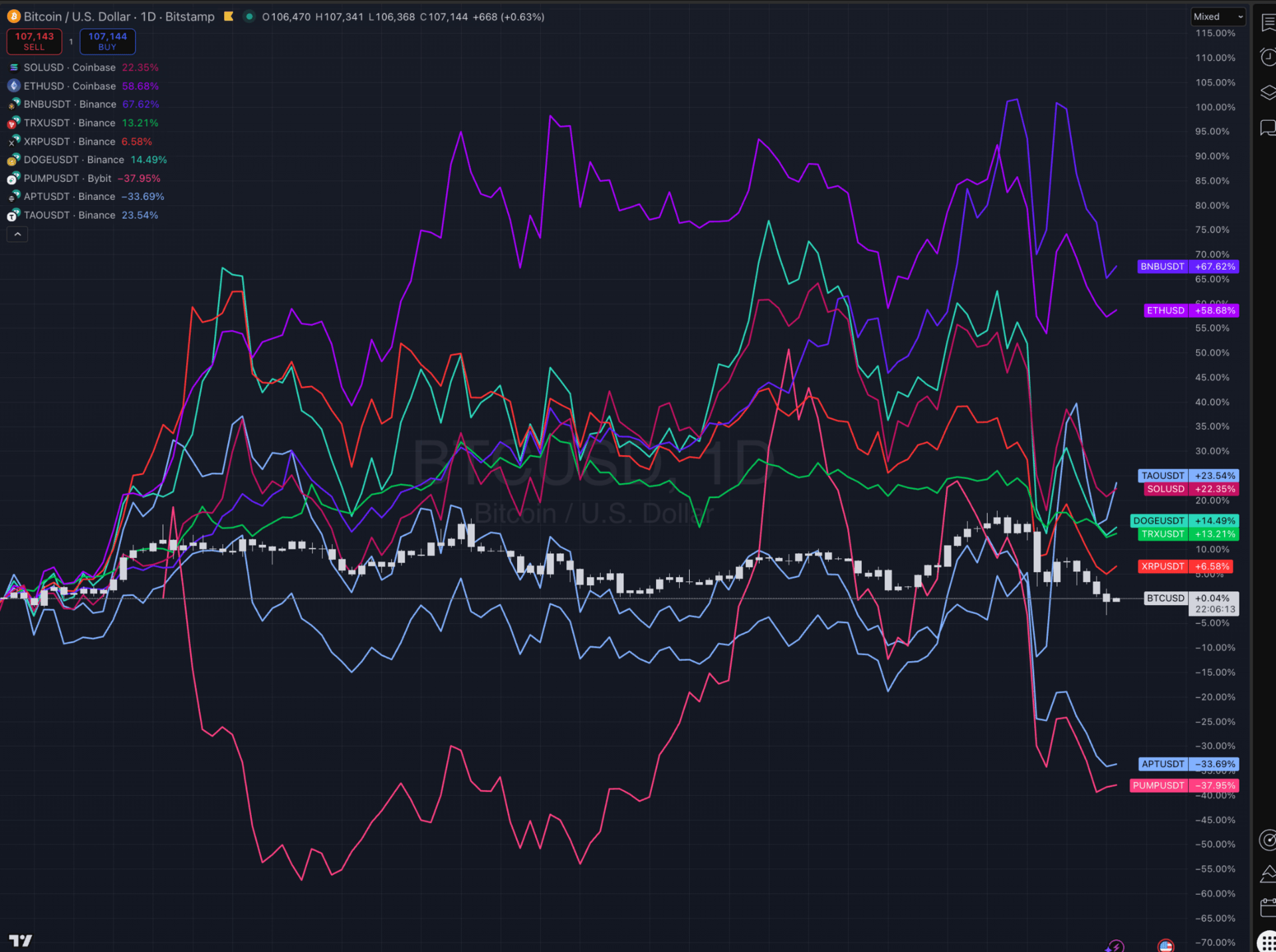
Smart Money Accumulation
Smart money stayed selective in Solana this week. Adds clustered in a few tickers while breadth was trimmed, consistent with a cautious, post-liquidation tape. KLED continued to attract steady wallet inflows and now carries the largest balance (~$1.61M). CARDS posted a clear week-over-week uptick with a near-$1M balance, and Tokabu printed the sharpest allocation jump on the board.
Outflows were broader. The heaviest cuts showed up in 1 and LION, with sizable week-over-week reductions. LAUNCHCOIN and Fartcoin were also pared, alongside smaller trims in SPARK and URANUS—de-risking rather than full exits given their still-meaningful balances.
One notable newcomer: BELIEVE entered the rankings this week with fresh wallet allocations and a solid starting balance (~$380K). Net-net, capital concentrated into a short list of higher-conviction names (KLED, CARDS, Tokabu) while cutting breadth elsewhere—an accumulation pattern that reads as risk-aware rather than risk-on.
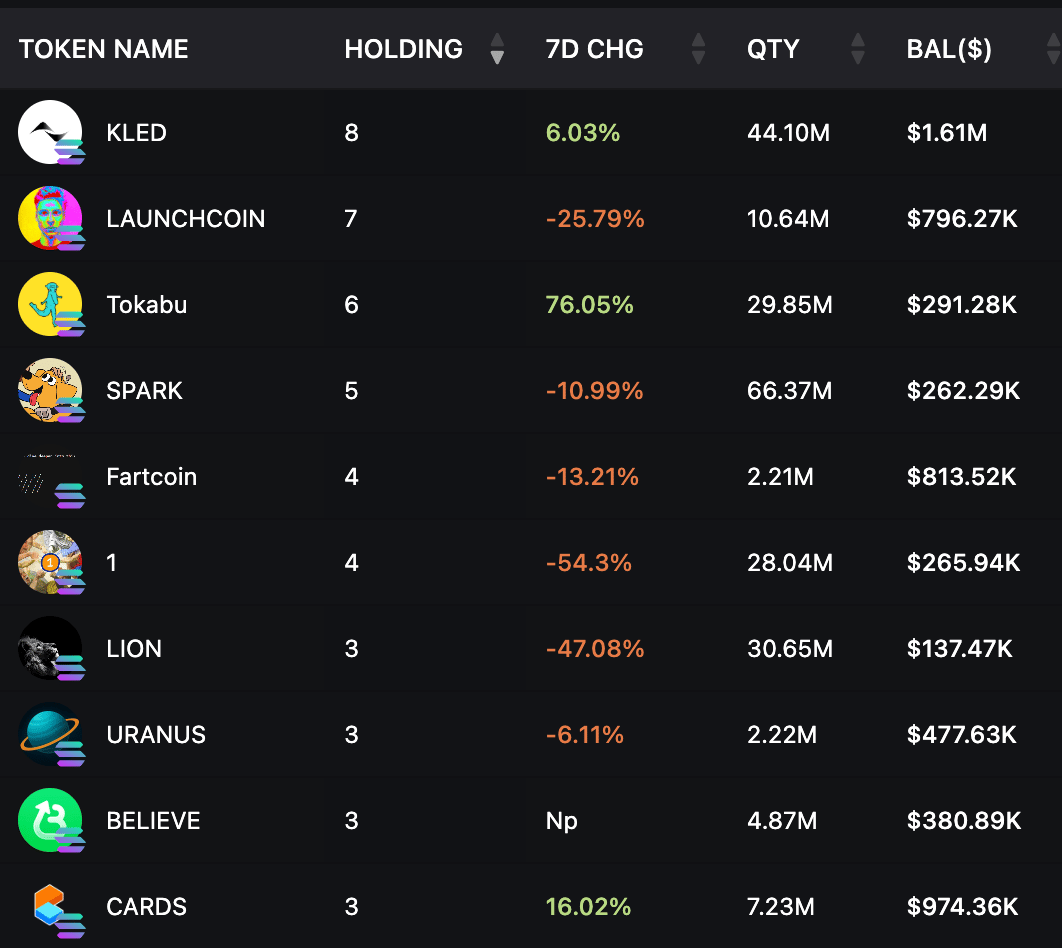
Smart money activity across the EVM ecosystem picked up selectively this week, with wallets showing a mix of strong accumulation in new or smaller names and profit-taking in older positions. SPX led inflows by a wide margin, seeing wallets more than double holdings and pushing balances toward the upper tier of tracked tokens. Block followed with a sharp surge in allocations, jumping nearly fivefold to emerge as one of the most notable new concentrations of capital. BOOE and CULT also attracted light but steady accumulation, maintaining consistent balances across active wallets.
On the other side, Mog saw significant trimming as holdings fell sharply, suggesting some unwinding after prior heavy positioning. PEPE slipped slightly, showing muted changes in wallet exposure, while larger meme positions like APU and TRWA held steady with no net inflows or exits—pointing to a wait-and-see approach rather than broad risk rotation.
The overall pattern suggests a tentative return of risk appetite, though positioning is still narrow and conviction appears focused on newer narratives rather than across-the-board buying.
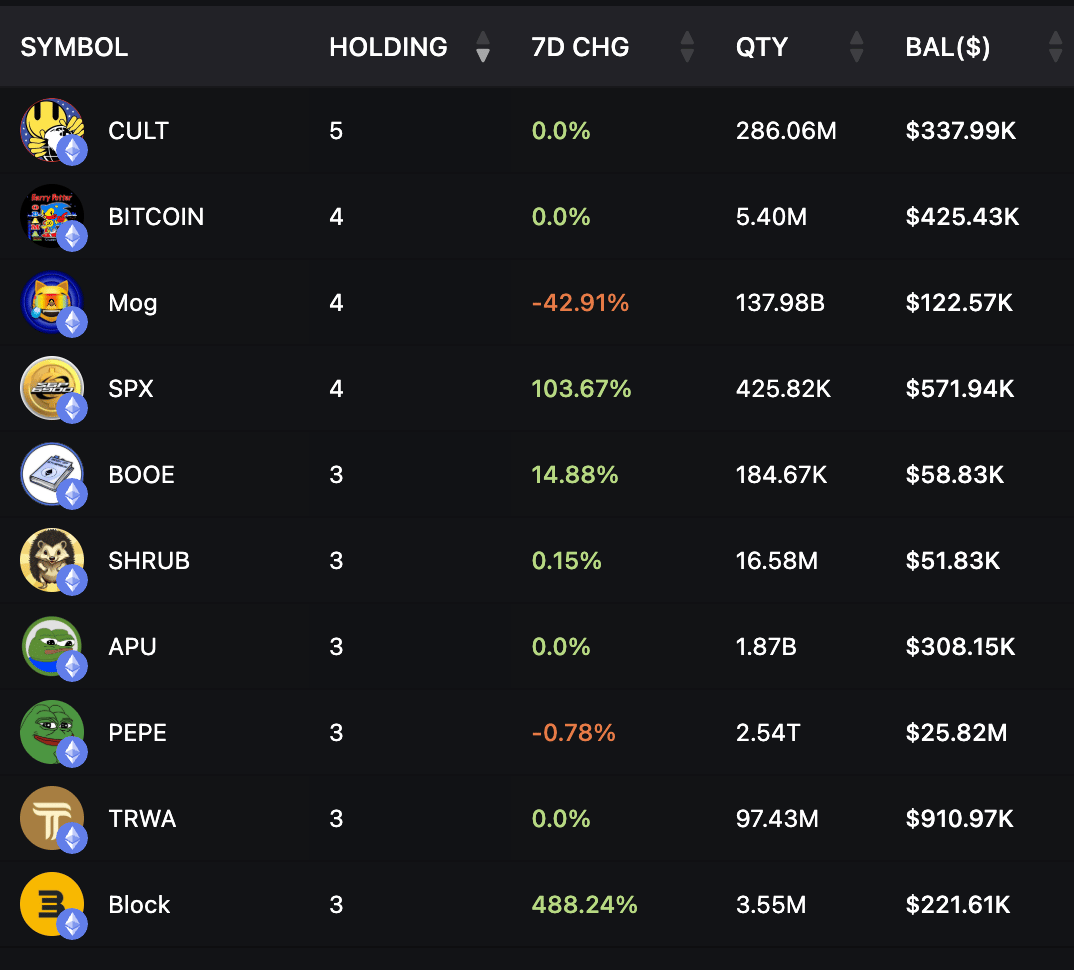
And zoning in on the BNB ecosystem now — activity remains mixed as traders weigh fresh opportunities against lingering caution following recent Binance headlines. Market leaders ASTER and COAI continue to dominate flows, though both saw choppy trading this week. COAI pulled back sharply after a strong multi-week run, while ASTER held firmer and still posted respectable weekly gains. Cake provided some steadiness, with modest inflows helping it remain one of the more stable DeFi plays in the group.
Further down the list, XPL and BAS showed brief bursts of strength before retracing, and KOGE, BLESS, and the 4 tokens traded largely flat on lower volume. Newer listings such as KGEN, RIVER, and ZBT lost momentum, underscoring thinner risk appetite across the ecosystem.
Overall, liquidity remains healthy but positioning is clearly more cautious. Traders are sticking to liquid names after last week’s deleveraging incident and the broader Binance-related FUD. The ecosystem is still active, but following its recent surge, capital rotation has slowed as participants take a breather and reassess exposure.
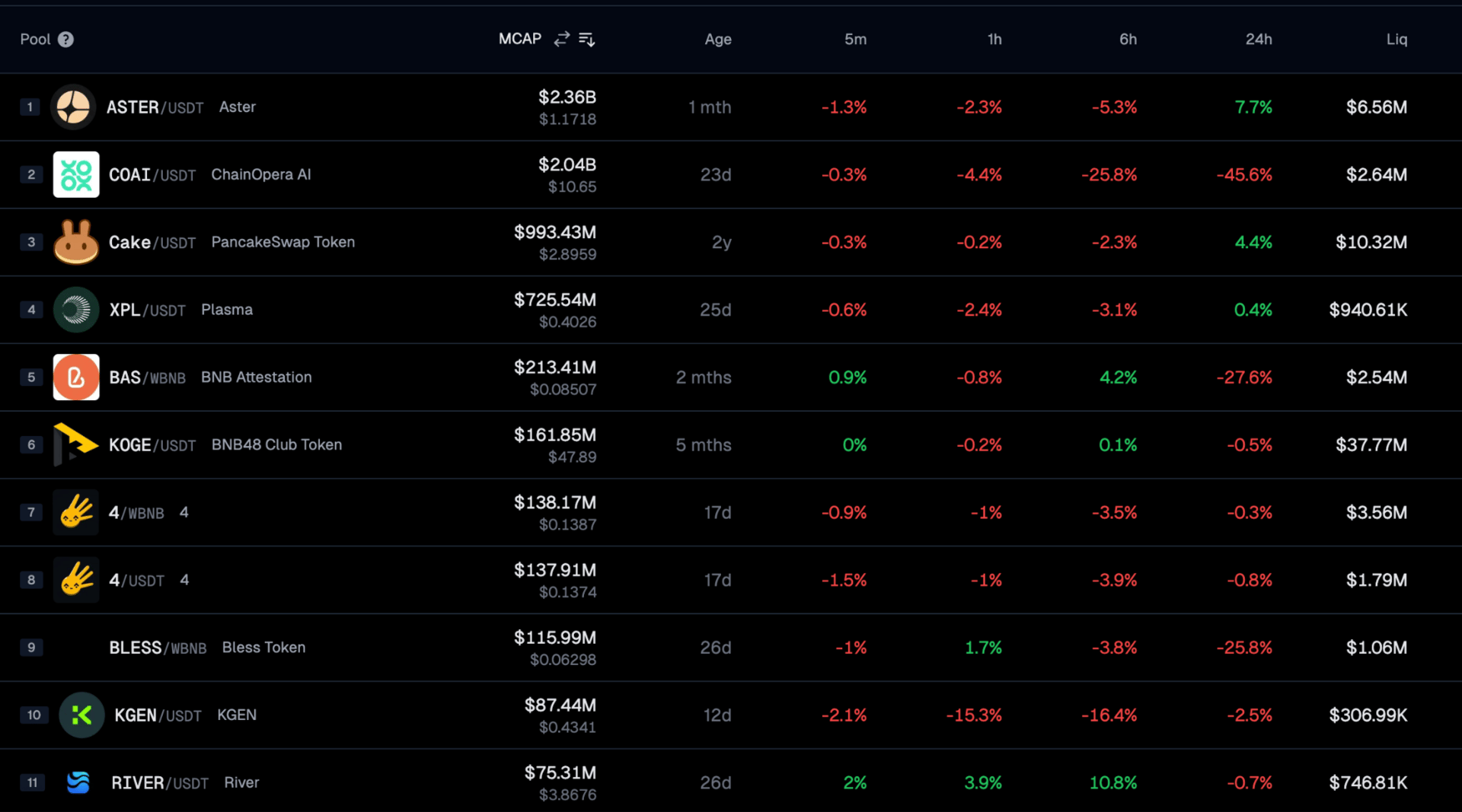
Have you been buying the dips since last week? |
That wraps up this post—we hope you found the insights valuable. See you next week, anon! 🚀
Reply